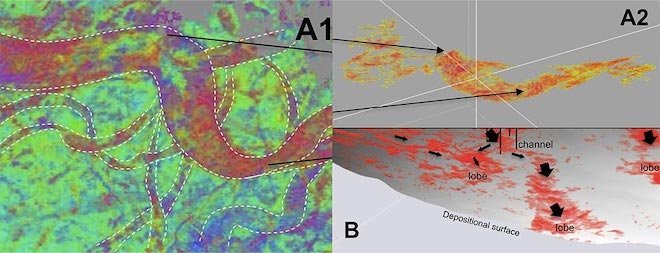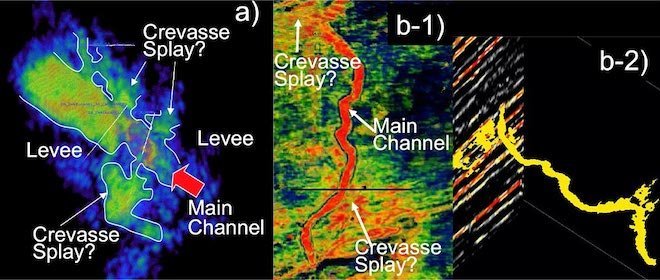3D Seismic Technology & Seismic Geomorphology
Seismic geomorphology is a technology for analyzing the distributions of reservoir rocks in three dimensions, which has been made available since the early 2000s with the evolution of 3D seismic technology and the application of sedimentology.
The seismic geomorphology analyzes 3D seismic attributes including amplitude, wavelet trace shape, and frequency, obtained through 3D seismic surveys, and visualize the distributions of reservoir rocks with high accuracy, which used to be estimated only using one or two dimensional data in the past. By combining the seismic geomorphology with sedimentology and the concept of sequence stratigraphy, we reconstruct the depositional geomorphology of fluvial channels, submarine fans and carbonate reefs, and then estimate the distributions of reservoir rocks.
In oil and gas explorations and CCS (Carbon dioxide Capture and Storage), it is highly important to estimate the distributions of reservoir rocks accurately. Accurate and precise estimation of reservoir rock distributions using seismic geomorphological methods helps reduce risks in exploration and uncertainty of reserve amount.
Case Examples by JAPEX
JAPEX has employed the above method in oil and gas explorations domestically and overseas, as well as in evaluation of CCS reservoirs.
Case example 1: Amplitude opacity rendering images of fluvial and submarine fan channels, and depositional lobes.
In amplitude opacity rendering, which is a typical seismic geomorphological analysis, an amplitude suggesting the presence of reservoir rocks in 3D seismic survey data is rendered as opacity, while other portions as transparent, displaying the distributions of reservoir rocks in 3D. In the images below, A1 and A2 represent fluvial channel reservoir rocks, while B represents submarine fan channels and lobes.

A1-A2: Results of amplitude opacity rendering of fluvial channel /B: Results of amplitude opacity rendering of submarine fan channels and lobes
(Source: Takano and Tsuji, 2013 (c)The Geological society of Japan=*1)
Case example 2: Amplitude opacity rendering of submarine fan channels and geobody detection
As well as opacity rendering, geobody detection is one of the major methods of seismic geomorphology. This method tracks reservoir rock-indicating amplitudes, and detects them as a series of geobody. a) and b-1) depict amplitude opacity rendering images of submarine fan channel reservoirs, whereas b-2) depicts the result of geobody detection of the channel reservoirs.

a): Results of amplitude opacity rendering of a submarine fan /b-1) & 2): Results of amplitude opacity rendering and reservoir geobody detection of deep-sea channels
(Source=*2)
Case example 3: 3D perspective view of depositional surfaces of a submarine-fan channel-levee system
By extracting reflection surface data and being overlaid with depth or amplitude values, a depositional surface can be displayed in 3D. The image below is an example of a 3D depositional surface display of a submarine-fan channel-levee system, depicting a channel, lobe, and natural levee.

3D depositional surface display of a submarine-fan channel-levee system
(Source:Takano and Tsuji, 2013 (c)The Geological society of Japan=*1)
(Source)
*1: Osamu Takano and Takashi Tsuji, 2013, 3D geology and reservoir modeling in oil industry: Geologic model construction by integration of sedimentology, sequence stratigraphy, seismic geomorphology, exploration geophysics and geostatistics, Jour. Geol. Soc. Japan, 119, 8, 567-579
*2: Osamu Takano and Mizue Nishimura, 2009, Practical insights into 3D seismic geomorphological analysis of reservoir distributions: Example of submarine-fan turbidite sandstone reservoirs, Jour. Japan. Assoc. Petrol. Tech., 74, 1, 40-51
Our website uses cookies to improve the convenience of our visitors when browsing our site. If you agree with our policy on the use of cookies, please click the "Agree" button. If you do not agree to the use of cookies when browsing our website, please disable the cookie setting in your browser.
